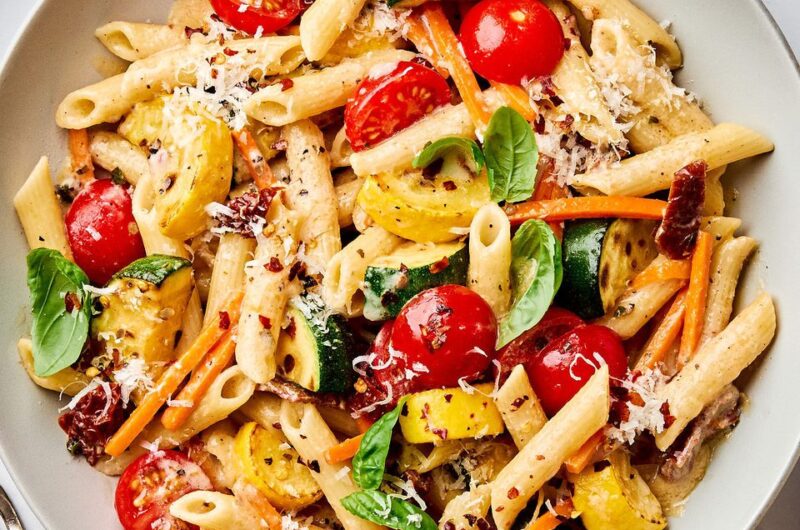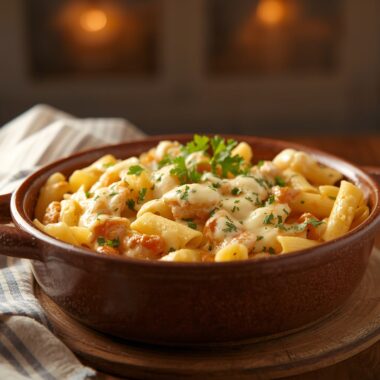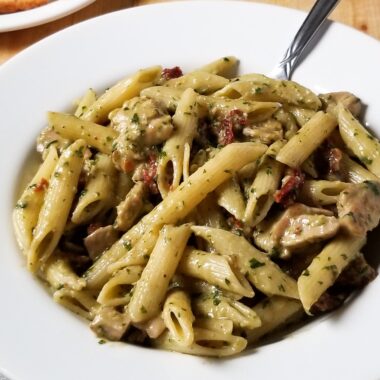Introduction
Pasta Primavera is the very definition of freshness on a plate. Literally meaning “springtime pasta” in Italian, this dish celebrates the bounty of seasonal vegetables by pairing them with tender pasta, garlic, olive oil, and a touch of Parmesan or light cream.
Unlike heavy pasta dishes, Pasta Primavera is light, colorful, and vibrant, making it a perfect choice for anyone who loves vegetables and wants a meal that is both comforting and healthy. It’s versatile enough for weeknight dinners, yet elegant enough for entertaining. The beauty lies in its adaptability—you can use whatever vegetables are fresh, local, and in season, giving it endless variations throughout the year.
Why I Love This Recipe
I love this recipe because it brings together two of my favorite things: pasta and fresh vegetables. Every forkful bursts with flavors of tender-crisp veggies, the richness of olive oil, and just the right amount of cheese or cream for balance.
It’s a dish that is endlessly customizable—you can make it vegetarian, add chicken or shrimp, or keep it vegan by skipping the cheese. Plus, it’s healthy without feeling restrictive; it’s packed with nutrients yet feels indulgent because of the pasta.
Another reason I adore it is its seasonal connection. In spring, you can use asparagus and peas; in summer, zucchini and bell peppers; in fall, broccoli and carrots. It truly makes the most of fresh produce all year round.
Why It’s a Must-Try Dish
Pasta Primavera is more than just a pasta dish—it’s a celebration of fresh, seasonal produce. What makes it truly special is how it turns simple ingredients into something vibrant, colorful, and incredibly satisfying. Each bite combines tender pasta with crisp-tender vegetables, lightly coated in olive oil, garlic, and Parmesan (or cream, if you prefer). It’s wholesome, refreshing, and versatile enough to please everyone at the table.
This dish is a must-try because it strikes the perfect balance between health and comfort. While many pasta recipes lean heavily on cheese and sauces, Pasta Primavera lets the vegetables shine, bringing a natural sweetness and crunch that you can’t help but love. It’s filling without being overly heavy, making it just as suitable for a weeknight family dinner as it is for a spring garden party or summer gathering.
Another reason it’s a must-try? Endless customization. You can adapt it to whatever vegetables are in season—zucchini and peppers in summer, asparagus and peas in spring, broccoli and carrots in fall, even hearty greens in winter. No two versions ever taste quite the same, which keeps it exciting.
And finally, Pasta Primavera is a wonderful way to introduce picky eaters to more vegetables. The combination of pasta, garlic, and Parmesan makes it approachable, while the colorful presentation makes it irresistible. It’s comfort food that nourishes, making it one of those timeless dishes that everyone should experience.
Preparation and Cooking Time
- Preparation Time: 15 minutes
- Cooking Time: 20 minutes
- Total Time: 35 minutes
Servings and Nutrition
- Servings: 4
- Calories (per serving): ~430 kcal
- Course: Main Course
- Cuisine: Italian-American
Ingredients
For the Pasta:
- 400 g (14 oz) penne, spaghetti, or fettuccine
- 1 tbsp salt (for pasta water)
For the Vegetables:
- 2 tbsp olive oil
- 2 cloves garlic, minced
- 1 small red bell pepper, sliced into strips
- 1 small yellow bell pepper, sliced into strips
- 1 medium zucchini, sliced into half-moons
- 1 medium carrot, julienned or thinly sliced
- 1 cup broccoli florets
- 1 cup cherry tomatoes, halved
- 1 cup fresh asparagus, cut into 2-inch pieces
- ½ cup frozen or fresh peas
- Salt and black pepper, to taste
For the Sauce & Garnish:
- ¼ cup vegetable broth or pasta water
- Juice of ½ lemon
- ½ cup grated Parmesan cheese (or vegan Parmesan substitute)
- 2 tbsp fresh parsley, chopped
- Optional: ¼ cup heavy cream for a creamier sauce
Directions (Step-by-Step Preparation Method)
Step 1: Cook the Pasta
- Bring a large pot of salted water to a boil.
- Add pasta and cook until al dente (about 1–2 minutes less than package instructions).
- Reserve ½ cup of pasta water, then drain the pasta and set aside.
Step 2: Sauté the Vegetables
- In a large skillet, heat olive oil over medium heat.
- Add garlic and sauté for 1 minute until fragrant.
- Add carrots, broccoli, and asparagus first (since they take longer to cook). Sauté for 3–4 minutes.
- Add bell peppers, zucchini, and peas, cooking for another 3–4 minutes.
- Stir in cherry tomatoes last, cooking just until softened.
- Season with salt and pepper.
Step 3: Make the Sauce
- Add lemon juice and a splash of vegetable broth (or pasta water) to deglaze the skillet.
- Stir in Parmesan cheese (and cream if using), mixing until slightly thickened.
Step 4: Toss Everything Together
- Add cooked pasta to the skillet, tossing with vegetables and sauce until well coated.
- If needed, add a bit more pasta water to loosen the sauce.
Step 5: Garnish and Serve
- Sprinkle with fresh parsley and extra Parmesan.
- Serve hot with lemon wedges on the side.
How to Serve
Serve Pasta Primavera immediately, topped with extra Parmesan and a drizzle of olive oil. Pair it with garlic bread and a fresh side salad for a complete meal. For drinks, a crisp white wine such as Pinot Grigio or Sauvignon Blanc works beautifully.
Recipe Tips
- Cut vegetables evenly so they cook at the same rate.
- Add harder vegetables (carrots, broccoli) before softer ones (zucchini, tomatoes).
- Don’t overcook the vegetables—they should remain tender-crisp for the best flavor and texture.
- Use seasonal vegetables for maximum freshness and flavor.
Variations
- Creamy Primavera: Add ½ cup heavy cream or mascarpone cheese for a richer sauce.
- Protein Boost: Add grilled chicken, shrimp, or chickpeas.
- Vegan Version: Use nutritional yeast instead of Parmesan and skip the cream.
- Whole Grain or Gluten-Free: Use whole-wheat or gluten-free pasta.
- Spicy Primavera: Add a pinch of red pepper flakes while sautéing the garlic.
Freezing and Storage
- Refrigerator: Store leftovers in an airtight container for up to 3 days.
- Freezer: Not recommended, as the vegetables may lose texture.
- Reheating: Warm gently in a skillet with a splash of olive oil or broth to refresh the sauce.
Special Equipment Needed
- Large pasta pot
- Large skillet or sauté pan
- Colander
- Wooden spoon
FAQ
Q1: Can I make this ahead of time?
Yes, you can cook the pasta and chop vegetables ahead of time, then quickly toss everything together before serving.
Q2: What other vegetables can I use?
Almost any seasonal vegetables work—eggplant, mushrooms, snap peas, spinach, or kale are great options.
Q3: Can I use frozen vegetables?
Yes, but fresh vegetables have better texture. If using frozen, thaw and drain before sautéing.
Q4: How do I keep it light but flavorful?
Use fresh lemon juice, high-quality olive oil, and fresh herbs to brighten flavors without adding heaviness.
Conclusion
Pasta Primavera with Fresh Seasonal Vegetables is a dish that celebrates simplicity, freshness, and flavor. It’s a canvas for creativity, allowing you to adapt it to the seasons and your personal taste. Light yet satisfying, healthy yet indulgent, it’s a pasta dish that everyone should try at least once—and once you do, it will likely become a regular on your dinner table.
Pasta Primavera with Fresh Seasonal Vegetables
Course: main courseCuisine: Italian-AmericanDifficulty: easy4
servings15
minutes20
minutes35
minutesIngredients
For the Pasta:
400 g (14 oz) penne, spaghetti, or fettuccine
1 tbsp salt (for pasta water)
For the Vegetables:
2 tbsp olive oil
2 cloves garlic, minced
1 small red bell pepper, sliced into strips
1 small yellow bell pepper, sliced into strips
1 medium zucchini, sliced into half-moons
1 medium carrot, julienned or thinly sliced
1 cup broccoli florets
1 cup cherry tomatoes, halved
1 cup fresh asparagus, cut into 2-inch pieces
½ cup frozen or fresh peas
Salt and black pepper, to taste
For the Sauce & Garnish:
¼ cup vegetable broth or pasta water
Juice of ½ lemon
½ cup grated Parmesan cheese (or vegan Parmesan substitute)
2 tbsp fresh parsley, chopped
Optional: ¼ cup heavy cream for a creamier sauce
Directions
- Step 1: Cook the Pasta: Bring a large pot of salted water to a boil. Add pasta and cook until al dente (about 1–2 minutes less than package instructions). Reserve ½ cup of pasta water, then drain the pasta and set aside.
- Step 2: Sauté the Vegetables: In a large skillet, heat olive oil over medium heat. Add garlic and sauté for 1 minute until fragrant. Add carrots, broccoli, and asparagus first (since they take longer to cook). Sauté for 3–4 minutes. Add bell peppers, zucchini, and peas, cooking for another 3–4 minutes. Stir in cherry tomatoes last, cooking just until softened. Season with salt and pepper.
- Step 3: Make the Sauce: Add lemon juice and a splash of vegetable broth (or pasta water) to deglaze the skillet. Stir in Parmesan cheese (and cream if using), mixing until slightly thickened.
- Step 4: Toss Everything Together: Add cooked pasta to the skillet, tossing with vegetables and sauce until well coated. If needed, add a bit more pasta water to loosen the sauce.
- Step 5: Garnish and Serve: Sprinkle with fresh parsley and extra Parmesan. Serve hot with lemon wedges on the side.





